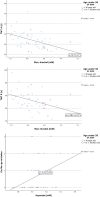Predicting performance in attention by measuring key metabolites in the PCC with 7T MRS
- PMID: 39048626
- PMCID: PMC11269673
- DOI: 10.1038/s41598-024-67866-1
Predicting performance in attention by measuring key metabolites in the PCC with 7T MRS
Abstract
The posterior cingulate cortex (PCC) is a key hub of the default mode network and is known to play an important role in attention. Using ultra-high field 7 Tesla magnetic resonance spectroscopy (MRS) to quantify neurometabolite concentrations, this exploratory study investigated the effect of the concentrations of myo-inositol (Myo-Ins), glutamate (Glu), glutamine (Gln), aspartate or aspartic acid (Asp) and gamma-amino-butyric acid (GABA) in the PCC on attention in forty-six healthy participants. Each participant underwent an MRS scan and cognitive testing, consisting of a trail-making test (TMT A/B) and a test of attentional performance. After a multiple regression analysis and bootstrapping for correction, the findings show that Myo-Ins and Asp significantly influence (p < 0.05) attentional tasks. On one hand, Myo-Ins shows it can improve the completion times of both TMT A and TMT B. On the other hand, an increase in aspartate leads to more mistakes in Go/No-go tasks and shows a trend towards enhancing reaction time in Go/No-go tasks and stability of alertness without signal. No significant (p > 0.05) influence of Glu, Gln and GABA was observed.
Keywords: 7T MRS; Aspartate; Attention; Cognition; GABA; Glutamate; Glutamine; Healthy; Inositol; Posterior cingulate cortex.
© 2024. The Author(s).
Conflict of interest statement
The authors declare no competing interests.
Figures



References
MeSH terms
Substances
LinkOut - more resources
Full Text Sources

